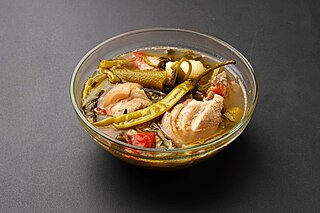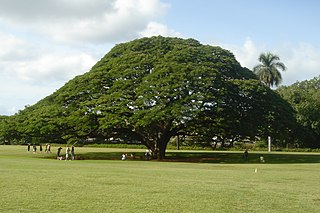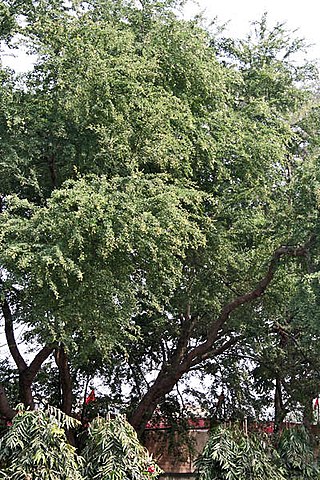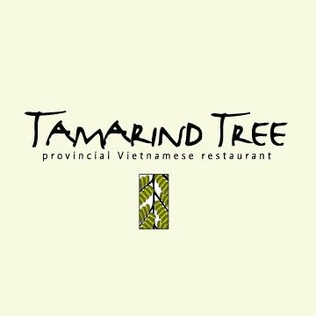Sycamore is a name which has been applied to several types of trees, but with somewhat similar leaf forms. The name derives from the ancient Greek συκόμορος (sūkomoros) meaning "fig-mulberry".

Tamarind is a leguminous tree bearing edible fruit that is indigenous to tropical Africa and naturalized in Asia. The genus Tamarindus is monotypic, meaning that it contains only this species. It belongs to the family Fabaceae.
Cypress is a common name for various coniferous trees or shrubs of northern temperate regions that belong to the family Cupressaceae. The word cypress is derived from Old French cipres, which was imported from Latin cypressus, the latinisation of the Greek κυπάρισσος (kyparissos). Cypress trees are a large classification of conifers, encompassing the trees and shrubs from the cypress family (Cupressaceae) and many others with the word cypress in their common name. Many cypress trees have needle-like, evergreen foliage and acorn-like seed cones.

White spruce is a common name for several species of spruce (Picea) and may refer to:

Sinigang is a Filipino soup or stew characterized by its sour and savory taste. It is most often associated with tamarind, although it can use other sour fruits and leaves as the souring agent. It is one of the more popular dishes in Filipino cuisine. The soup is usually accompanied by rice. In 2021, sinigang was rated as the world's best vegetable soup by TasteAtlas. In December 2023, the website project's TasteAtlas Awards 2023/24 included sinigang among its "100 best dishes in the world".

Samanea saman is a species of flowering tree in the pea family, Fabaceae, now in the Mimosoid clade and is native to Central and South America. It is often placed in the genus Samanea, which by yet other authors is subsumed in Albizia entirely.

Pithecellobium dulce, commonly known as Manila tamarind, Madras thorn, monkeypod tree or camachile, is a species of flowering plant in the pea family, Fabaceae, that is native to the Pacific Coast and adjacent highlands of Mexico, Central America, and northern South America. It is also sometimes known as monkeypod, but that name is also used for several other plants, including Samanea saman. It is an introduced species and extensively naturalized in the Caribbean and Florida, as well as the Philippines and Guam via the Manila galleons. It has also been introduced to Thailand and South Asia, It is considered an invasive species in Hawaii.
Tamarindo is the Spanish word for a tamarind.
Morachi Chincholi, by name itself means a village of tamarind trees (Marathi:chincha) and town of dancing peacocks all around. It is situated near Pune-Ahmednagar Highway about 55 km from Pune. Even today one can find a lot of peafowls in the village.

Lysiloma latisiliquum, commonly known as false tamarind or wild tamarind, is a species of tree in the family Fabaceae, that is native to southern Florida in the United States, the Bahamas, Cuba, southern Mexico, and Belize. Its wood is sometimes traded as sabicu wood.
ASAM or Asam may refer to:

Diploglottis australis, known as the native tamarind, is a well known rainforest tree of eastern Australia. It is easily identified by the large sausage shaped leaflets.

Cupaniopsis anacardioides, with common names tuckeroo, carrotwood, beach tamarind and green-leaved tamarind, is a species of flowering tree in the soapberry family, Sapindaceae, that is native to eastern and northern Australia. The usual habitat is littoral rainforest on sand or near estuaries. The range of natural distribution is from Seven Mile Beach, New South Wales to Queensland, northern Australia and New Guinea.

The Black Bulga State Conservation Area is a protected conservation area located near the Barrington Tops, in the Hunter Region of New South Wales, Australia. The 1,554-hectare (3,840-acre) conservation area is situated 16 kilometres (9.9 mi) from Dungog, and used to be part of Trevor State Forest and Chichester State Forest.
Velvet tamarind is a common name for several trees in the genus Dialium and may refer to:
Tamarind is a species of tree and the fruit from that tree.

William Wyndham's gravesite is a heritage-listed lone grave at Boyne Island, Gladstone Region, Queensland, Australia. It is also known as Carnym and Wyndhams Farm. It was added to the Queensland Heritage Register on 23 June 2000. It is within the Wyndham Park Heritage Site, accessed between 36 and 38 Alkina Street.

Tamarind Tree is a Vietnamese restaurant in Seattle, in the U.S. state of Washington.
This page is based on this
Wikipedia article Text is available under the
CC BY-SA 4.0 license; additional terms may apply.
Images, videos and audio are available under their respective licenses.










